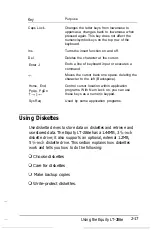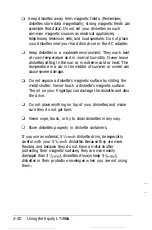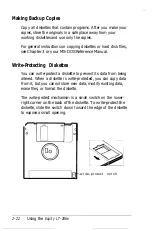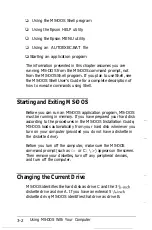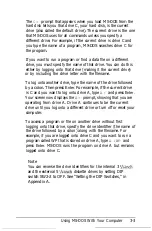
How Diskettes Work
The diskettes you use are flexible plastic, coated with a
magnetic material and enclosed in a protective plastic case.
Information is recorded in magnetic patterns on both surfaces
of the diskette. Because data is stored magnetically, you can
retrieve, record, and erase data, just as you play, record, and
erase music on cassette tapes.
When you insert a diskette in a drive, a metal shutter above the
diskette’s access area moves aside to expose the diskette surface.
When your computer reads data from or writes data to the
diskette, it causes the diskette to spin within its plastic casing.
Then the drive’s read/write head locates the appropriate
position on the diskette and performs the operation you specify.
Choosing Diskettes for the Equity LT-286e
Be sure to buy high-quality diskettes to use in your Equity
LT-286e. You can use two kinds of diskettes:
3
720KB, double-sided, double-density diskettes
3
1.44MB, double-sided, high-density diskettes.
On a 720KB diskette, you can store the equivalent of about
300 pages of text. You can store twice as much information on
1.44MB diskettes, but the 3
diskette drives on some
computers cannot use these high-capacity diskettes. If you are
planning to exchange data with a computer that has a 720KB
diskette drive, use 720KB diskettes in your Equity LT-286e.
If you have an external, 5
1.2MB (high-capacity)
diskette drive, use 5
double-sided, high-density
diskettes in this drive. These diskettes can hold the equivalent
of about 500 pages of text and are compatible with the high-
capacity diskette drives used on some models of the IBM AT.
The 1.2MB diskette drive can read 360KB diskettes.
2-18
Using
the Equity LT-286e
Summary of Contents for Equity LT-286e
Page 1: ......
Page 3: ...EPSON E Q U l T Y T M L T T M 2 8 6 e User s Guide ...
Page 6: ...iv ...
Page 161: ......














